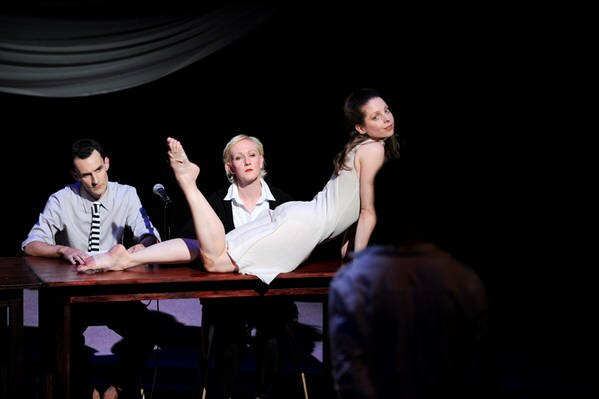 Julie Tobiason, Timothy Lynch, Alexandra Dickson in Project Orpheus (Photo credit: zebravisual)
Julie Tobiason, Timothy Lynch, Alexandra Dickson in Project Orpheus (Photo credit: zebravisual)
Seattle Dance Project is doing a "back by popular demand" revival of its Project Orpheus (through Sept. 25 at ACT), which had its premiere in 2008.
SDP's retelling of the Greek myth unites the talents of three choreographers, Eva Stone, Wade Madsen, and Olivier Wevers; and music that ranges from Steve Beresford to Steve Reich, with Anthony and the Johnsons ("Hope There's Someone") and Fauré as well.
It's stunningly sad. It's also raucous, petty, and sexy. As dance, at base it's modern, but informed by ballet and by the age and experience of its performers. The intimacy of the ACT space connects you viscerally with the effortful demands dance makes on the body, rather than gravity-defying ballet's spectacle. (I say that for contrast, not categorically.)
This doesn't happen that often, but I have to apologize for losing some of my critical wits during the performance; some moments I can't describe for you, which I suppose is one of the better reasons I could give for suggesting you go see it yourself. No one can promise catharsis, but if you're in the mood for it, this is a good stop.
So, Orpheus is a famous poet and musician, but you know who's even more famous? Hades. That's perhaps why Project Orpheus opens with a dapper, suited Timothy Lynch standing standing, keeping a slow (heart) beat with his foot, eleven times. (Later he will reappear in front of you, lighting and blowing out a cigarette lighter, his neck craned forward, tightening the skin on his face so that the last thing your widening pupils take in is a death's head.) His arms take in the globe, describe the seas' waves; he reaches down to flat-palm the ground, blows dust away.
Julie Tobiason with Joseph Anderson, Betsy Cooper, and Kory Perigo in Project Orpheus (Photo credit: zebravisual)
The Furies arrive in hoots and hops, to a little circus of the damned music from Beresford. Stone gives them a chaotic, bumping, physical presence and you can decipher what they each are about. Kory Perigo swats at the air, as if tormented by gnat-sized Furies himself, grins with a blank lewdness, and hungers for things--like a heart?--to eat.
Michele Curtis has a sinewy strut and a prowling look, and I kept imagining her eyes were about to turn pure black like one of the demons on Supernatural. Alexandra Dickson is nominally a Fury, but she seemed to have a more regal (at times) personality, interacting with Lynch's Hades (Stone has her collide with Lynch's upper body, then roll down his torso and curved leg as if he's both barrier and launch pad.) The Furies burlesque the sentiments of Orpheus and Eurydice (and explain forthrightly that's what they're doing). They operate as a one-eyed, reductionist chorus home in both society at large and anyone's mind.
Because you are introduced to Hades and the Furies first, there's a distinct menace when they appear as guests at a party (Wade Madsen's choreography, inimitably enlivened by magnetism and momentum--people pair off or are pulled apart, movement itself propagates or ends relationships). Joseph Anderson's Orpheus doesn't know he's just cut in on a Fury; neither does Julie Tobiason's Eurydice.
But as Orpheus and Eurydice discover their attraction--Madsen's choreography knits into Stone's for the Love Duet so cleanly you don't notice the transition--you're witness to a gorgeous string of movements: An entangled lift where Eurydice is suspended by Anderson's arm, then turns with his hand at the nape of her neck, following her swerve--Eurydice is always swerving. When she dances toward Orpheus at the party, it's in a combination that breaks right and left.
Joseph Anderson in Project Orpheus (Photo: zebravisual)
For the snakebite scene, Madsen has Furies Perigo and Curtis tease Eurydice before turning on her, and Tobiason's growing panic as she realizes that something is wrong, is cutting her off, carrying her away is about where I lose the ability to tell you what the dance looked like.
It's followed by the supercharged grief of Orpheus (here, Olivier Wevers steps in as choreographer, and if you're used to his more wry, airily balletic transports, this is a change of pace). Anderson collapses to the floor, and, facedown, arches from his midsection--it's a little like if you've had appendicitis and are trying to find that one position that quiets the pain for a second. Or if you're vomiting with nothing left.
On his feet again, pushing up with both hands, he whirls, pulls at his shirt as if it's skin, freezes there.
After this, it comes as a relief that later the "Request for Eurydice," set in the underworld, is played as a gag grant-request, with Hades and the Furies as deadpan interrogators, wondering aloud how granting Orpheus his request will serve the larger community, and whether this isn't some kind of vanity project. It's funny, but it's not entirely out of place. In a real-world sense, the procedures of bureaucracy are deadening, flattening.
After this kind of entr'acte, you still have Wevers' take on the journey out of the underworld--blind in the dark, in dream, Orpheus and Eurydice reunite like sex-starved otters. That nape-of-the-neck gesture returns--and so does a reprise of Orpheus's dance of loss, the taut, whipping purgation set this time against a lachrymose Fauré piece.
 Subscribe to our Front Page Stories
Subscribe to our Front Page Stories
![]() Subscribe to all SunBreak Stories
Subscribe to all SunBreak Stories

Most Recent Comments